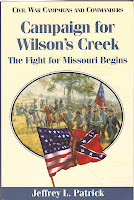Soon, a Civil War series
sponsored by the Springfield-Greene County Library District (Springfield, Missouri) and focusing on the
year 1863 will begin. Comprising a dozen talks altogether, the series starts on
July 10th and runs through July 22nd. Additionally,
special guided tours of the Wilson’s Creek National Battlefield as well as a
tour of sites associated with the Battle of Springfield will be conducted.
In conjunction with a
Civil War Round Table meeting, I will start the series on July 10th
at 7:00 pm with a presentation about Albert C. Ellithorpe and the 1st
Indian Home Guards. The talk will focus on the nature of warfare in the
trans-Mississippi and the role of Indian troops. Other paper topics and their
presenters include the battle of Honey Springs (Ralph Jones), Ulysses S. Grant
(Pam Sanfilippo), the massacre at Baxter Springs (Matt Matthews), the Vicksburg
campaign (Terry Winschel), Guerrillas, Civilians, and the Nature of Warfare in
the Trans-Mississippi (Matt Stith), the raid on Lawrence (Jeremy Neely), the
campaign to take Little Rock (Mark Christ), Longstreet and the Gettysburg
Controversy (William Piston), George Meade: the Victor of Gettysburg (Michael
Price), the hospital diary of Corporal William Miller, 75th Indiana
Infantry (Jeffrey Patrick), and From Virginia to Missouri: The Civil War in
1863 (William Piston). The series closes with a book discussion group led by
Steven E. Woodworth. For complete information on topics, dates, times, etc. see
the Springfield-Greene County Library District website.



